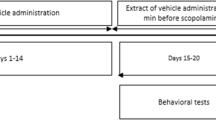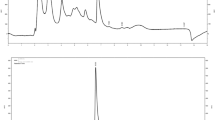Abstract
The antioxidant activity of proanthocyanidins extracted from the lotus seedpods (LSPC) in vitro and ameliorative effects on memory impairment induced using scopolamine in mice were studied. 2,2-diphenyl-1-picrylhydrazyl (DPPH) radical scavenging ability, oxygen radical absorbance capacity, and cellular antioxidant activity assays revealed a potent LSPC antioxidant activity. Y-maze and step-down avoidance testing showed that LSPC administration at 30, 60, and 90 mg/kg ameliorated memory impairment. LSPC improved glutathione peroxidase and superoxide dismutase activities, inhibited activities of monoamine oxidase-B, total nitric oxide synthase, neuronal nitric oxide synthase, and acetylcholinesterase, and had no influence on inducible nitric oxide synthase and nitric oxide levels in the brain. LSPC ameliorated scopolamineinduced memory impairment based on improvement of the antioxidant system and cholinergic activity, which may be associated with potent antioxidant ability.
Similar content being viewed by others
References
Roberson ED, Mucke L. 100 years and counting: Prospects for defeating Alzheimer’s disease. Science 314: 781–784 (2006)
Reddy VP, Zhu X, Perry G, Smith MA. Oxidative stress in diabetes and Alzheimer’s disease. J. Alzheimers Dis. 16: 763–774 (2009)
Devasagayam TPA, Tilak JC, Boloor KK, Sane KS, Ghaskadbi SS, Lele RD. Free radicals and antioxidants in human health: Current status and future prospects. J. Assoc. Physician. I. 52: 794–804 (2004)
Reiter RJ. Oxidative processes and antioxidative defense mechanisms in the aging brain. FASEB J. 9: 526–533 (1995)
Bonda DJ, Wang XH, Perry G, Nunomura A, Tabaton M, Zhu XW, Smith MA. Oxidative stress in Alzheimer disease: A possibility for prevention. Neuropharmacology 59: 290–294 (2010)
Markesbery WR, Kryscio RJ, Lovell MA, Morrow JD. Lipid peroxidation is an early event in the brain in amnestic mild cognitive impairment. Ann. Neurol. 58: 730–735 (2005)
Jeong EJ, Lee KY, Kim SH, Sung SH, Kim YC. Cognitiveenhancing and antioxidant activities of iridoid glycosides from Scrophularia buergeriana in scopolamine-treated mice. Eur. J. Pharmacol. 588: 78–84 (2008)
Van der Vliet A, Bast A. Effect of oxidative stress on receptors and signal transmission. Chem.-Biol. Interact. 85: 95–116 (1992)
Gong YS, Liu LG, Xie BJ, Liao YC, Yang EL, Sun ZD. Ameliorative effects of lotus seedpod proanthocyanidins on cognitive deficits and oxidative damage in senescence-accelerated mice. Behav. Brain Res. 194: 100–107 (2008)
Xu JQ, Rong S, Xie BJ, Sun ZD, Zhang L, Wu HL, Yao P, Zhang YJ, Zhang XP, Liu LG. Rejuvenation of antioxidant and cholinergic systems contributes to the effect of procyanidins extracted from the lotus seedpod ameliorating memory impairment in cognitively impaired aged rats. Eur. Neuropsychopharm. 19: 851–860 (2009)
Kopelman MD, Corn TH. Cholinergic ‘blockade’ as a model of cholinergic depletion: a comparison of the memory deficits with those of Alzheimer-type dementia and the alcoholic korsakoff syndrome. Brain 111: 1079–1110 (1988)
Kwon S-H, Lee H-K, Kim J-A, Hong S-I, Kim H-C, Jo T-H, Park Y-I, Lee C-K, Kim Y-B, Lee S-Y, Jang C-G. Neuroprotective effects of chlorogenic acid on scopolamine-induced amnesia via antiacetylcholinesterase and anti-oxidative activities in mice. Eur. J. Pharmacol. 649: 210–217 (2010)
Aron PM, Kennedy JA. Flavan-3-ols: Nature, occurrence and biological activity. Mol. Nutr. Food Res. 52: 79–104 (2008)
Lee YA, Cho EJ, Yokozawa T. Oligomeric proanthocyanidins improve memory and enhance phosphorylation of vascular endothelial growth factor receptor-2 in senescence-accelerated mouse prone/8. Brit. J. Nutr. 103: 479–489 (2010)
Yokozawa T, Lee YA, Zhao Q, Matsumoto K, Cho EJ. Persimmon oligomeric proanthocyanidins extend life span of senescenceaccelerated mice. J. Med. Food 12: 1199–1205 (2009)
Li SZ. Fruits. p. 1893. In: Compendium of Materia Medica. Liu HR (ed). People’s Medical Press, Beijing, China (1982)
Ling ZQ, Xie BJ, Yang EL. Isolation, characterization, and determination of antioxidative activity of oligomeric proanthocyanidins from the seedpod of Nelumbo nucifera Gaertn. J. Agr. Food Chem. 53: 2441–2445 (2005)
Zhang L, Xu JQ, Rong S, Xie BJ, Sun ZD, Zhang YJ, Liu LG. The mixture of procyanidins extracted from the lotus seed pod and bilobalide ameliorates scopolamine-induced memory impairment in mice. Neurosci. Bull. 25: 203–208 (2009)
Xiao J, Sui Y, Li SY, Wu Q, Yang T, Xie BJ, Sun ZD. Combination of proanthocyanidins extracted from lotus seedpod and L-cysteine ameliorates memory impairment induced by alcohol and scopolamine in mice. Eur. Food Res. Technol. 236: 671–678 (2013)
Porter LJ, Hrstich LN, Chan BG. The conversion of proanthocyanidins and prodelphinidins to cyanidins and delphinidin. Phytochemistry 25: 223–230 (1986)
Sahin S, Samli R. Optimization of olive leaf extract obtained by ultrasound-assisted extraction with response surface methodology. Ultrason. Sonochem. 20: 595–602 (2013)
Wolfe KL, Liu RH. Structure-activity relationships of flavonoids in the cellular antioxidant activity assay. J. Agr. Food Chem. 56: 8404–8411 (2008)
El-Sherbiny DA, Khalifa AE, Attia AS, Eldenshary EED. Hypericum perforatum extract demonstrates antioxidant properties against elevated rat brain oxidative status induced byamnestic dose of scopolamine. Pharmacol. Biochem. Be. 76: 525–533 (2003)
Lee M-R, Yun B-S, Zhang D-L, Liu L, Wang Z, Wang C-L, Gu L-J, Wang C-Y, Mo E-K, Ly S-Y, Sung C. Effect of aqueous antler extract on scopolamine-induced memory impairment in mice and antioxidant activities. Food Sci. Biotechnol. 19: 655–661 (2010)
Lee M-R, Yun B-S, Zhang D-L, Liu L, Wang Z, Wang C-L, Gu L-J, Wang C-Y, Mo E-K, Ly S-Y, Sung C. Anti-amnesic effect of chongmyung-tang on scopolamine-induced memory impairments in mice. J. Ethnopharmacol. 132: 70–74 (2010)
Chen L, Richardson JS, Caldwell JE, Ang LC. Regional brain activity of free radical defense enzymes in autopsy samples from patients with Alzheimer’s disease and from nondemented controls. Int. J. Neurosci. 75: 83–90 (1994)
Ali AK, Banks WA, Kumar VB, Shah GN, Lynch JL, Farr SA, Fleegal-DeMotta MA, Morley JE. Nitric oxide activity and isoenzyme expression in the senescence-accelerated mouse P8 model of Alzheimer’s disease: Effects of anti-amyloid antibody and antisense treatments. J. Gerontol. A-Biol. 64: 1025–1030 (2009)
Xu JQ, Rong S, Xie BJ, Sun ZD, Deng QC, Bao W, Wang D, Yao P, Huang FH, Liu LG. Changes in the nitric oxide system contribute to effect of procyanidins extracted from the lotus seedpod ameliorating memory impairment in cognitively impaired aged rats. Rejuv. Res. 14: 33–43 (2011)
Kalinchuk AV, Stenberg D, Rosenberg PA, Porkka-Heiskanen T. Inducible and neuronal nitric oxide synthases (NOS) have complementary roles in recovery sleep induction. Eur. J. Neurosci. 24: 1443–1456 (2006)
Zoubovsky SP, Pogorelov VM, Taniguchi Y, Kim S-H, Yoon P, Nwulia E, Sawa A, Pletnikov MV, Kamiya A. Working memory deficits in neuronal nitric oxide synthase knockout mice: Potential impairments in prefrontal cortex mediated cognitive function. Biochem. Bioph. Res. Co. 408: 707–712 (2011)
Przedborski S, Jackson-Lewis V, Yokoyama R, Shibata T, Dawson VL, Dawson TM. Role of neuronal nitric oxide in 1-methyl-4-phenyl-1,2,3,6-tetrahydropyridine (MPTP)-induced dopaminergic neurotoxicity. P. Natl. Acad. Sci. USA 93: 4565–4571 (1996)
Domek-£opaciñska KU, Strosznajder JB. Cyclic GMP and nitric oxide synthase in aging and Alzheimer's disease. Mol. Neurobiol. 41: 129–137 (2010)
Boultadakis A, Pitsikas N. Effects of the nitric oxide synthase inhibitor L-NAME on recognition and spatial memory deficits produced by different NMDA receptor antagonists in the rat. Neuropsychopharmacol. 35: 2357–2366 (2010)
Yang Z-J, Carter EL, Torbey MT, Martin LJ, Koehler RC. Sigma receptor ligand 4-phenyl-1-(4-phenylbutyl)-piperidine modulates neuronal nitric oxide synthase/postsynaptic density-95 coupling mechanisms and protects against neonatal ischemic degeneration of striatal neurons. Exp. Neurol. 221: 166–174 (2010)
Giacobini E. Cholinesterases: New roles in brain function and in Alzheimer’s disease. Neurochem. Res. 28: 515–522 (2003)
Author information
Authors and Affiliations
Corresponding author
Rights and permissions
About this article
Cite this article
Xiao, J., Li, S., Sui, Y. et al. In vitro antioxidant activities of proanthocyanidins extracted from the lotus seedpod and ameliorative effects on learning and memory impairment in scopolamine-induced amnesia mice. Food Sci Biotechnol 24, 1487–1494 (2015). https://doi.org/10.1007/s10068-015-0192-y
Received:
Revised:
Accepted:
Published:
Issue Date:
DOI: https://doi.org/10.1007/s10068-015-0192-y




